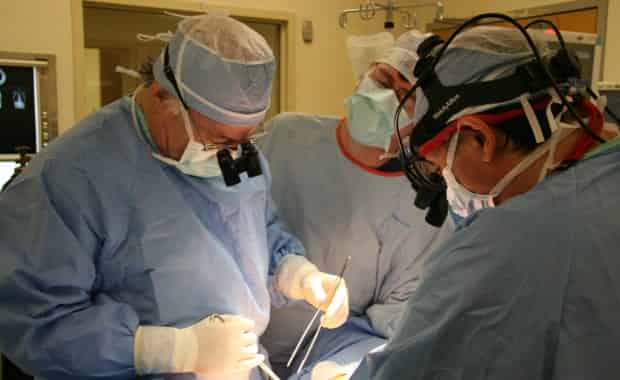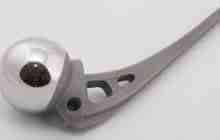
Partial hip replacement, also called hip hemiarthroplasty, is a surgical procedure where only the femoral head (the ball) of the damaged hip joint is replaced. The acetabulum (the socket) is not replaced. By contrast, in total hip replacement, the acetabulum is replaced with a prosthetic.
Broken and fractured hips – traumatic hip injury – are the primary reason for partial hip replacement. It is not typically a treatment for degenerative arthritis in the hip joint, as total hip replacement surgery is.
Partial vs. Total Hip Replacement Surgery
Partial hip replacement and total hip replacement generally treat two different types of issues (injury vs. degenerative arthritis, respectively). Partial hip replacement isn’t a treatment for bone disease because when the femoral head is arthritic, the acetabulum has generally also degenerated and is unstable, making a total hip implant necessary to hold the prosthetic femoral head in place (this is known as total hip replacement).
In partial hip replacement, where there is a fracture in the femoral neck and the fracture cannot be pinned, the ball must be replaced but the socket is still strong (see: partial hip implants).
Commonly referred to as a ‘broken hip’, the fractured neck of the femur is categorized according to the actual level of the fracture and the degree of damage that has occurred.
Grades of fracture
Basically there are four different categories or “grades” of fracture (See: Appendix A). Grades 1, 2 and 3 – subtrochanteric, intertrochanteric and fractured neck – don’t interfere with the joint at all and will generally be repaired with pins or nailing devices.
Grade 4 – subcapital fracture – is graded into four “types”, according to the amount of displacement at the fracture site.
- Type 1 is a stable fracture with impaction, meaning the bones are pressed together.
- Type 2 is complete but non-displaced, meaning the bones remain aligned as they were pre-fracture.
- Type 3 is displaced but the two bone fragments have some contact with one another.
- Type 4 is completely displaced and there is no contact between the fracture fragments.
Types 1, 2 and 3 can be fixed with pins or a nailing device. Type 4 will involve disruption of the blood supply to the femoral head with early bone death. This fracture is highly unlikely to heal if it is pinned like the other categories. In this situation, partial hip replacement or hemiathroplasty is required.
Hemiarthroplasty simply involves removing the broken femoral head, trimming the fractured end of the neck and inserting a one piece prosthesis of stem and ball. The socket or acetabulum is never interfered with as it is still in very good condition.
More about partial hip replacement implants >>
When is hemiarthroplasty recommended?
Because younger people can sometimes suffer a Type 4 subcapital fracture, a hemiarthroplasty is not normally used because metal prosthesis bearing against bone is not the optimal solution. It can result in wear on the bone and possibly even to the point of wearing away the base of the socket. For this reason, certain patients – young patients and also very able and active older patients – may have a total hip replacement performed as an emergency procedure, rather than a partial hip replacement.
Even in the event of this type of hip fracture, a partial hip replacement is only recommended on occasion and generally only when the patient is elderly and in poor health.
Complications
As with any serious operation, complications can occur. Fracture of the femur may occur during the procedure, although this is rare, occurring in under 5% of cases.1 Dislocation, infection, loosening of the implant, and post operative pain are all complications that may occur after a partial hip replacement procedure.
For a variety of reasons, your surgeon may decide it is more suitable to treat your fractured hip with a total hip replacement rather than a partial hip replacement, even if you have no evidence of osteoarthritis. Your surgeon may feel a total hip replacement would be in your best interest if you have other conditions, such as thin bone in the socket, a bone cyst in the femur or pelvis, or an additional fracture elsewhere around your hip joint.
As with any orthopedic surgery and, certainly, with any hip replacement surgery, patients are best-advised to speak with their chosen orthopedic surgeon about all available surgical and conservative options. He or she will give you a recommendation based upon your specific circumstances and their history and familiarity with certain implants and procedures.
Appendix A
Classifications of fractured neck of femur (Fig. 1)
- Classification 1: subcapital fracture
- Classification 2: fracture of the neck of femur
- Classification 3: intertrochanteric fracture
- Classification 4: subtrochanteric fracture (also called an upper third fracture of the shaft
Only subcapital fractures are likely to require hemiarthroplasty depending upon the grade classification
Grades of subcapital fracture (Fig. 2)
- Grade I: partial subcapital fracture
- Grade II: undisplaced subcapital fracture
- Grade III: partially displaced subcapital fracture
- Grade IV: displaced subcapital fracture
There are various methods of dealing with a subcapital fracture of the femur. First depends upon the grade and the upon the viability of the blood supply to the head.
- In Grade I the blood supply is intact, can be pinned and will heal successfully.
- In Grade II, though the blood supply is severed, there is every chance the head may yet survive and the bone heal. However, if there is evidence on the xray that the bone in the head is failing, then a hemiarthroplasty will be necessary.
- In Grade III, if the head is still viable (not showing signs of bone death) and the fracture can be reduced (put back together) then it may be pinned but the chances are that a hemiarthroplasty will be necessary.
- In Grade IV a hemiarhroplasty will always be required.
Sources
- The Merck Manual, “Hip Fractures” http://www.merckmanuals.com/home/injuries_and_poisoning/fractures/hip_fractures.html
image credit: crucially
Filed Under: Hip ReplacementHip Replacement, Resurfacing, Revision







